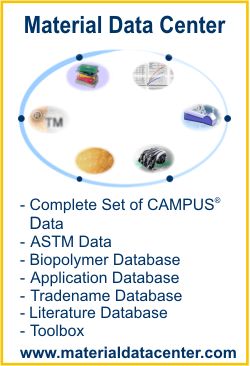Material Data Center is a leading international information system for the plastics industry. Material Data Center offers a comprehensive plastics database, calculation tools, CAE interfaces, a literature database and an application database. For more information about Material Data Center visit www.materialdatacenter.com.
This is the free Material Data Center Datasheet of Ultraform® N2640 E2 AT - (POM+MBS) - BASF
unit conversion, PDF datasheet print, comparison with other plastics, snap fit calculation, beam deflection calculation, CAE Interfaces
Check here, which other Ultraform datasheets, application examples or technical articles are available in Material Data Center
Abbreviated designation according to ISO 1043-1: POM-HI
Designation according to ISO 29988-POM-K,,M-GNPR,2-1
| Caractéristiques des transformations/physiques | Valeur | Unité | Norme du test | ||||||||||||||||||||||||||||||||||||||||||||||||||||||||||||||||||||||||||||||||||||||||||||||||
| ISO Data | |||||||||||||||||||||||||||||||||||||||||||||||||||||||||||||||||||||||||||||||||||||||||||||||||||
| Indice de fluidité à chaud en volume, MVR | 6 | cm³/10min | ISO 1133 | ||||||||||||||||||||||||||||||||||||||||||||||||||||||||||||||||||||||||||||||||||||||||||||||||
| Température | 190 | °C | - | ||||||||||||||||||||||||||||||||||||||||||||||||||||||||||||||||||||||||||||||||||||||||||||||||
| Charge | 2.16 | kg | - | ||||||||||||||||||||||||||||||||||||||||||||||||||||||||||||||||||||||||||||||||||||||||||||||||
| Retrait au moulage, parallèle | 1.9 | % | ISO 294-4, 2577 | ||||||||||||||||||||||||||||||||||||||||||||||||||||||||||||||||||||||||||||||||||||||||||||||||
| Retrait au moulage, perpendiculaire | 1.9 | % | ISO 294-4, 2577 | ||||||||||||||||||||||||||||||||||||||||||||||||||||||||||||||||||||||||||||||||||||||||||||||||
| Propriétés mécaniques | Valeur | Unité | Norme du test | ||||||||||||||||||||||||||||||||||||||||||||||||||||||||||||||||||||||||||||||||||||||||||||||||
| ISO Data | |||||||||||||||||||||||||||||||||||||||||||||||||||||||||||||||||||||||||||||||||||||||||||||||||||
| Module en traction | 2200 | MPa | ISO 527 | ||||||||||||||||||||||||||||||||||||||||||||||||||||||||||||||||||||||||||||||||||||||||||||||||
| Contrainte d'écoulement | 50 | MPa | ISO 527 | ||||||||||||||||||||||||||||||||||||||||||||||||||||||||||||||||||||||||||||||||||||||||||||||||
| Déformation au seuil d'écoulement | 8 | % | ISO 527 | ||||||||||||||||||||||||||||||||||||||||||||||||||||||||||||||||||||||||||||||||||||||||||||||||
| Déformation nominale à la rupture | 50 | % | ISO 527 | ||||||||||||||||||||||||||||||||||||||||||||||||||||||||||||||||||||||||||||||||||||||||||||||||
| Résistance au choc Charpy (entaillé), +23°C | 9 | kJ/m² | ISO 179/1eA | ||||||||||||||||||||||||||||||||||||||||||||||||||||||||||||||||||||||||||||||||||||||||||||||||
| Résistance au choc Charpy (entaillé), -30°C | 7 | kJ/m² | ISO 179/1eA | ||||||||||||||||||||||||||||||||||||||||||||||||||||||||||||||||||||||||||||||||||||||||||||||||
| Ball indentation hardness | 110 | MPa | ISO 2039-1 | ||||||||||||||||||||||||||||||||||||||||||||||||||||||||||||||||||||||||||||||||||||||||||||||||
| Propriétés thermiques | Valeur | Unité | Norme du test | ||||||||||||||||||||||||||||||||||||||||||||||||||||||||||||||||||||||||||||||||||||||||||||||||
| ISO Data | |||||||||||||||||||||||||||||||||||||||||||||||||||||||||||||||||||||||||||||||||||||||||||||||||||
| Température de fusion, 10°C/min | 166 | °C | ISO 11357-1/-3 | ||||||||||||||||||||||||||||||||||||||||||||||||||||||||||||||||||||||||||||||||||||||||||||||||
| Température de fléchissement s/chrg, 1.80 MPa | 80 | °C | ISO 75-1/-2 | ||||||||||||||||||||||||||||||||||||||||||||||||||||||||||||||||||||||||||||||||||||||||||||||||
| Température de ramolliss. Vicat, B | 140 | °C | ISO 306 | ||||||||||||||||||||||||||||||||||||||||||||||||||||||||||||||||||||||||||||||||||||||||||||||||
| Coeffic. de dilatation therm. linéique, parallèle | 130 | E-6/K | ISO 11359-1/-2 | ||||||||||||||||||||||||||||||||||||||||||||||||||||||||||||||||||||||||||||||||||||||||||||||||
| Propriétés électriques | Valeur | Unité | Norme du test | ||||||||||||||||||||||||||||||||||||||||||||||||||||||||||||||||||||||||||||||||||||||||||||||||
| ISO Data | |||||||||||||||||||||||||||||||||||||||||||||||||||||||||||||||||||||||||||||||||||||||||||||||||||
| Permittivité relative, 100Hz | 3.6 | - | IEC 62631-2-1 | ||||||||||||||||||||||||||||||||||||||||||||||||||||||||||||||||||||||||||||||||||||||||||||||||
| Permittivité relative, 1MHz | 3.5 | - | IEC 62631-2-1 | ||||||||||||||||||||||||||||||||||||||||||||||||||||||||||||||||||||||||||||||||||||||||||||||||
| Facteur de pertes, 100Hz | 30 | E-4 | IEC 62631-2-1 | ||||||||||||||||||||||||||||||||||||||||||||||||||||||||||||||||||||||||||||||||||||||||||||||||
| Facteur de pertes, 1MHz | 80 | E-4 | IEC 62631-2-1 | ||||||||||||||||||||||||||||||||||||||||||||||||||||||||||||||||||||||||||||||||||||||||||||||||
| Résistivité transversale | 1E12 | Ohm*m | IEC 62631-3-1 | ||||||||||||||||||||||||||||||||||||||||||||||||||||||||||||||||||||||||||||||||||||||||||||||||
| Résistivité superficielle | 1E15 | Ohm | IEC 62631-3-2 | ||||||||||||||||||||||||||||||||||||||||||||||||||||||||||||||||||||||||||||||||||||||||||||||||
| Rigidité diélectrique | 42 | kV/mm | IEC 60243-1 | ||||||||||||||||||||||||||||||||||||||||||||||||||||||||||||||||||||||||||||||||||||||||||||||||
| Indice de résistance au cheminement | 600 | - | IEC 60112 | ||||||||||||||||||||||||||||||||||||||||||||||||||||||||||||||||||||||||||||||||||||||||||||||||
| Propriétés diverses | Valeur | Unité | Norme du test |
| Absorption d'eau | 0.9 | % | Sim. to ISO 62 |
| Absorption d'humidité | 0.2 | % | Sim. to ISO 62 |
| Masse volumique | 1350 | kg/m³ | ISO 1183 |
| Bulk density | 850 | kg/m³ | - |
Pre/Post-processing, max. allowed water content: .2 %
Pre/Post-processing, Pre-drying, Temperature: 100 °C
Pre/Post-processing, Pre-drying, Time: 3 h
PROCESSING
injection molding, Melt temperature, range: 190 - 220 °C
injection molding, Melt temperature, recommended: 200 °C
injection molding, Mold temperature, range: 60 - 80 °C
injection molding, Mold temperature, recommended: 80 °C
injection molding, Dwell time, thermoplastics: 10 min
Processing
Usual single-flighted three-section screws with an effective screw length of at least 15 D, better 20 - 23 D are suitable for the injection molding of Ultraform.
Pretreatment
Granules or pellets in original packaging can be processed without any special pretreatment. Granules or pellets which have become moist due to prolonged or incorrect storage (e.g. by formation of condensed water) must be dried in dehumidifying or recirculating air dryers for approx. 3 hours at about 100 - 110 °C. The moisture content should not exceed 0.2 %.
Postprocessing
If parts were produced at a comparatively low mold temperature (e.g. in order to obtain short cycle times) and must not change their geometry in use thermal postprocessing inducing dimensional changes by postcrystallization may be necessary. In such cases parts should be stored in an oven with recirculated air at temperatures of 100 - 130 °C until dimensions don't change significantly any further. The time needed for this has to be determined experimentally.
Material Data Center is provided by M-Base Engineering + Software GmbH. M-Base Engineering + Software GmbH assumes no liability for the system to be free of errors. Any decision about the application of materials must be double checked with the producer of this material.
Additional information about this material, like producer contact address, etc. can be found at www.materialdatacenter.com. For access to this extra information a registration is requested. Free online registration is available.















